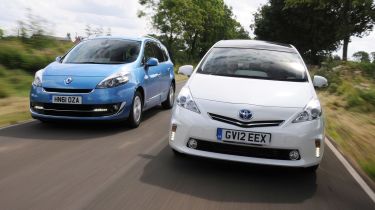Toyota Prius+ vs Renault Grand Scenic
First challenge is for new hybrid people carrier to beat seven-seat compact MPV star
In the 15 years since the launch of the original Prius, Toyota has successfully championed the petrol/electric concept, and now sells 19 hybrid models in 80 countries.
But given the challenges of packaging batteries within a functional MPV cabin, is a hybrid the best solution for clean, frugal and practical family motoring? Diesel rivals, after all, are almost as clean.
Well, Toyota is keen to stress that the Prius+ is more than just a ballooned version of the standard car. The styling is familiar, but it’s longer, wider, higher and, significantly, has a longer wheelbase, by 80mm.
Still, the biggest change is the location of the batteries. The seven-seater uses lithium-ion batteries, which are smaller and lighter than the nickel-metal hydride type used in the standard car. This allows the stack to be positioned vertically in the centre console, between the front seats – which in turn frees up space further back in the cabin.
Wide rear doors mean it’s easy to get into the Prius+, but while each row is mounted 45mm higher than the one in front, to give a decent view ahead, the rearmost chairs are tight on space. You’re forced to sit in a hips low/knees high position, but even then, legroom is in short supply for adults, while the tapered roof pinches headroom.
Used - available now

2022 Mercedes
GLC
35,715 milesAutomaticDiesel2.0L
Cash £30,587
2021 Mazda
CX-5
14,540 milesManualPetrol2.0L
Cash £19,887
2023 Land Rover
Range Rover Evoque
20,056 milesManualDiesel2.0L
Cash £21,787
2022 Kia
e-Niro
54,760 milesAutomaticElectric
Cash £15,287Small quarter light windows add to the sense of claustrophobia, although it’s better news in the middle row. The translucent plastic panoramic roof lets in lots of light, while the trio of independent chairs slides back and forth. The middle one is a bit narrow, but a flat floor means plenty of foot room.
The middle row seats fold flat, although unlike those in the Renault, they don’t tumble forward and can’t be removed altogether, so with all the chairs folded you get a chasm of wasted space between rows three and two. In addition, a small tailgate opening makes it tricky to slot in large items. Also counting against the Prius+ is the fact that the boot is shorter than the Scenic’s, whether you’ve got five or seven seats in place.
While the Renault has a similar layout, it’s more adaptable and provides slightly more space in row three, plus the middle seat in row two is wider.
Across the cabin, the Scenic also benefits from better-quality plastics – in fact, the materials are smarter overall. But the cabin isn’t perfect: accessing the rearmost seats involves flipping the outer middle row seats in a two-step operation, plus the back doors are smaller than the Scenic’s, although there’s still a big enough gap to clamber through.
Up front, both cars have a decent driving position, but again the Renault is the more upmarket of the pair. Its full-colour digital flatscreen display is more modern than the LCD unit in the Toyota, while an electric parking brake frees up space for a large sliding storage bin between the front seats.
Still, you need this room as the Renault surrenders most of its glovebox to the fuse panel, while the Toyota has a handy double glovebox. But the Scenic hits back in terms of family friendly appeal with underfloor cubbies, rear seat tray tables, a child view mirror and big door pockets.
On the road, it extends its advantage even further. While the Renault feels a bit sluggish initially, due to its tall gearing and modest 108bhp output, once the healthy 260Nm of torque comes into play in the mid-range, acceleration is similar to the Prius’.
Crucially, the 1.5-litre dCi is smooth and refined on the move, whereas in the Toyota even small amounts of acceleration result in an assault on the ears, as the raucous 1.8-litre petrol engine’s revs are sent soaring by the CVT gearbox.
As with other Prius models, you can only stay in silent EV mode at low speed for short periods. Plus, it doesn’t ride and handle as well as the Scenic and is noisier on motorways.
Add grabby brakes, a relatively firm ride and slow steering, and the Prius+ makes you feel like you have to compromise in the name of low emissions. And this could be a crucial failing, as the Renault emits only 4g/km more CO2, at 105g/km, and was 2.4mpg more fuel efficient during its time with us.
But the icing on the cake for the Scenic is its price – it’s £7,870 cheaper, at £21,625. Things aren’t looking good for the Prius+ here.







